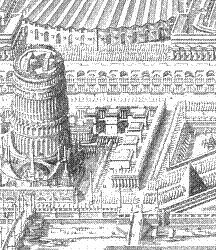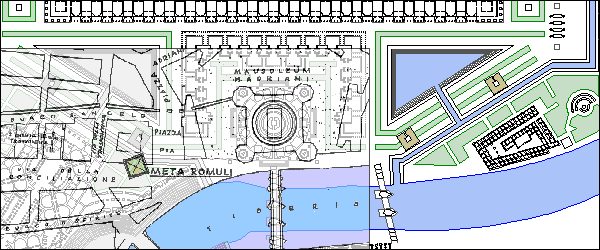The Longest Axis / The Axis of Life
1997.09.21
program of the Area Martis
1997.12.29
Piranesi seems to have designed the Area Martis with the writings of Josephus in mind (as cited in Plattus "Passage into the City"). Piranesi calls the immediate zone around the adjacent Templum Martis "apparatorium triumphatorium"--place of preparation for the triumphal procession, and the many tabernae surrounding the Area Martis seem to be there to accomodate the triumphator and his troops the night before the day of procession. See Plattus p.104-5.
The first arch the procession goes through (and actually the only arch the way goes through within the Ichnographia) is the arch of Trajan. Although there is nothing spectacular in terms of triumph per se that is associated with Trajan. ...the "planned" lineage (literally) going from Trajan to Hadrian to Antoninus Pius along the longest axis (of life) -- from arch to tomb to arch--which corresponds with the historical lineage of imperial sucession. ...all the emperors from Nerva to Antoninus Pius are clearly "marked throughout the Horti Domitiae--there is a statue of Nerva beside the Templ. Plotinae.
Points of Departure
1998.01.07
I have decided to put together a critical essay regarding my interpretations and disputations of the contemporary existing texts on the Ichnographia. It will be called "Points of Departure"...
...this combined presentation technique may also follow Piranesi's methodology, thus offering the possibility of a further "re-enactment".
In thinking of the typologies... ...regard to Tafuri's comments of the Ichnographia being a sample book and something unknowable. ...the [scale] comparison between St. Peter's and the Bustum Hadriani is a perfect place to start, although I could also compare the Ichnographia plans to other ancient Roman plans, particularly the large baths. Such drawings would refute Tafuri's and Bloomer's statements regarding the smallness (and seemingly insignificantly treated Pantheon and tomb of Hadrian).
...Piranesi's cribbing of the Porticus Aemilia for the Septa Julia may actually represent Piranesi's scale for the entire Ichnographia. It could be that Piranesi very purposefully installed the Forma Urbis fragment of the Porticus Aemilia into the Ichnographia for the precise purpose of demonstrating more of the actual scale (and gigantism) of ancient Rome (--it is as if Piranesi is here illustrating his own quote about how one just has to look around at Rome and Hadrian's Villa to see the examples he emulates.) Piranesi was not being deceptive or misleading, nor was he acting out of ignorance of the fragment's true identity. Piranesi used the Porticus Aemilia as evidence and example.
Hadrian, Plotina, and Paulina Domitia, etc.
1998.06.02
According to the biography of Hadrian, he was a favorite of Plotina. In fact, there is some cause to believe that it was Plotina that got Hadrian named as sucessor at Trajan's deathbed. ...more symbolism along the axis of life.
Hadrian's birth mother's name was Paulina Domitia, and this fact lead to further speculation as to the meaning of the Sepulchra Familiae Domitorum at the end of the axis of death--the counter point of Hadrian's tomb. There is reference to both Hadrian's real mother and to his adoptive mother within the axes of life and death.
...sheds light on Piranesi's overall intention in (re-)designing (not reconstructing) the Campo Marzio. Piranesi was redrawing/redesigning the Campo Marzio, a redesign not at all capricious, but one based wholeheartedly on a vast amouint of historical facts. That is to say, Piranesi set out to improve the ancient Campo Marzio's "urban plan" without changing the region's existing program.
...reminded of Stirling's notion of evolutionary designing, and his statements about what could or should be considered when designing a house for K.F. Schinkel 200 years after Schinkel's birth. I am also reminded of Tafuri's wrongness in calling the Ichnographia of the Campo Marzio an "experimental design and therefore an unknown."
Piranesi operated on a few planes when generating his plan of the Campo Marzio--there is the redesigned plane, the Pagan-Christian narrative plane, and the plane of (composite?) temporal palimpsest. To make matters difficult, however, none of these planes complies completely with the other two, nor can any of the planes be viewed completely independent of the other two. In essence, Piranesi's (design) methodology emulates the very nature of Rome itself. The Ichnographia is a plan of many layers of meanings and messages which ultimately aptly represents Rome the city of many physical and historical layers.
As an archeologist, Piranesi "redraws" all the layers of Rome's ancient past. As a well educated 18th century Roman Catholic, he "drafts" the narrative of Rome's Pagan to Christian inversion (conversion), and as a highly evolved architect-designer he displays the "Eternal City" with infinite virtuality.
| |
Meta Romuli
1998.07.17
Piranesi designates two pairs of pyramids along the canals and pools (stagnum) situated either side of the Sepulchum Hadriani. No specific names are applied to these pyramids, and the word pyramis is their only label. Together with Hadrian's Tomb, they establish a grand symmetrical layout that extends throughout the Horti Domitiae and includes the Bustum Hadriani. As a group, the four pyramids have no historical or archeological validity, however, the position of the pyramid closest to Hardian's Tomb, on the side facing St. Peter's, is remarkably close to the verified position of the Meta Romuli. This correspondence of placement between the real pyramid and Piranesi's imaginary one could be an uncanny coincidence, or it could be an example of a methodology Piranesi used to aid in piecing together his overall Campo Marzio design. If the latter is true, then Piranesi willfully manipulated a historical artifact to conform to his preferred design scheme. Moreover, Piranesi's exact mirroring of the Meta Romuli suggests careful maneuvering rather than whimsical play. The Ichnographia pyramid is in essence an inversion of the Meta Romuli.
| |

Detail of the Campo Marzio frontispiece showing the relationship between the Sepulchrum Hadriani and one of its four flanking pyramids.
|
 Overlay of the Ichnographia and the site plan of the Meta Romuli.
Overlay of the Ichnographia and the site plan of the Meta Romuli.
|
excerpts from Procopius
1998.10.06
Tafuri, Manfredo
1998.11.16
After an extended independent analysis of the Ichnographia Campus Martius, it becomes evident that Tafuri misreads Piranesi's large plan in most cases. Tafuri's text indicates no research of the plan beyond simply looking at it and subsequently offering a description of what Tafuri thinks he sees. (In fact, a careful reading of both Tafuri's texts and the text of Fasolo from 1956, clearly shows that Fasolo's text greatly influenced Tafuri's observations.) For example, in calling out the various axes of the Campo Marzio, Tafuri notes the axis running through Hadrian's Tomb, but he fails to recognize it's symbolic function as the Axis of Death; nor does he identify the Axis of Life that runs perpendicular to the Axis of Death. Moreover, Tafuri marginally notes the semblance of an axis within the northeast sector of the plan, yet he never mentions that Piranesi labeled this axis the Equiria, place of the annual horse races instituted by Romulus in honor of Mars.
These are just two examples which plainly demonstrate that Piranesi's plan holds significant and coherent symbolic content, however, recognition of Piranesi's "carved in stone" symbolism necessarily negates Tafuri's primary thesis that the Ichnographiam Campi Martii is utterly fragmented and devoid of "language." Ironically, had Tafuri not discounted the presence of language and instead actually translated the hundreds of Latin labels Piranesi applies throughout the plan, he would have concluded with a more accurate, if not also a more honest reading.
It is truly unfortunate that the subsequent 20th century Campo Marzio analyses of Allen, Bloomer, and Eisenman, build upon Tafuri's mistakes rather than correct them.
eros et thanatos
2683g
1999.01.29
Pagan - Christian - Triumphal Way
3123h
3123i
3123j
3123k
1999.11.21
The place where the bodies of the dead were burned and buried under Hadrian
2001.07.18
Campo Marzio and Philadelphia
2003.08.14
in the thick of reenactment season
2003.09.04 18:08
I purposefully walked from the front door of the Philadelphia Museum of Art down the Benjamin Franklin Parkway to the far side of Logan Circle and then back to the Art Museum. I did this to get a real sense of the scale of the virtual axis of life within Piranesi's Ichnographia Campus Martius.
In reality I was walking across the forecourt of the Philadelphia Museum of Art, then down the steps that Rocky made famous running up, then across Eakins Oval, where the largest painting in the world once was, then down a tree covered allee along the south side of the Parkway stretching for three long blocks, then around Logan Circle, and then back in the direction I came although this time along the north side of the Parkway.
In virtuality I was walking through the Nympheum Neronis high on the Vatican Hill, through the Porticus Neronianae, through the Templum Martis (Temple of Mars), through the Area Martis where the Triumphal Way begins its "march" (this is around where the Rodin Museum is on the Benjamin Franklin Parkway, and, as luck would have it, where the route of many of today's Philadelphia parades begin), then I walked around Hadrian's tomb, and then I walked back.
The whole walk took about 40 minutes, and if I had gone all the way to the LOVE sculpture at JFK Plaza across from City Hall, the walk back and forth would have taken just about an hour. ... I made mental note of most of the memorials on and along this stretch of the Parkway--Washington Memorial, Civil War Memorial, WWI Memorial, a plaque in the cement on axis at Logan Circle states that the trees along the Parkway were planted on honor of the soldiers of WWI, and a Shakespeare Memorial in front of the Free Library.
|

 Overlay of the Ichnographia and the site plan of the Meta Romuli.
Overlay of the Ichnographia and the site plan of the Meta Romuli.